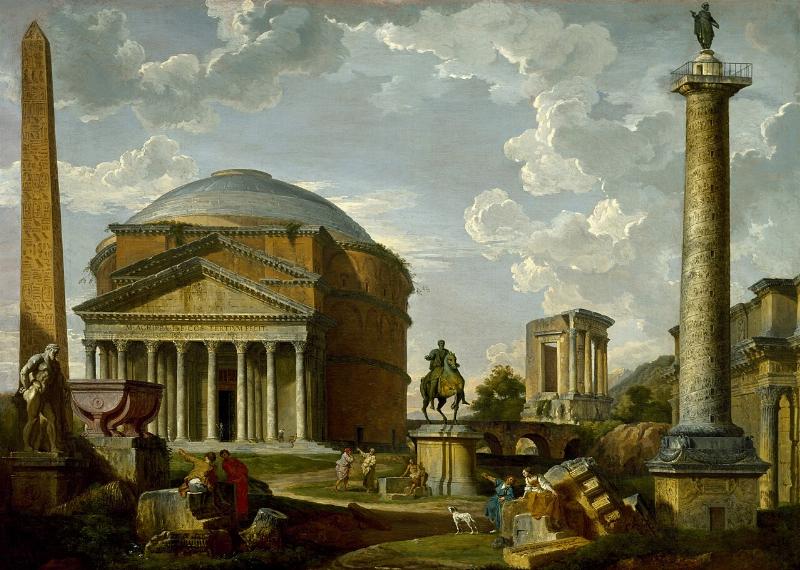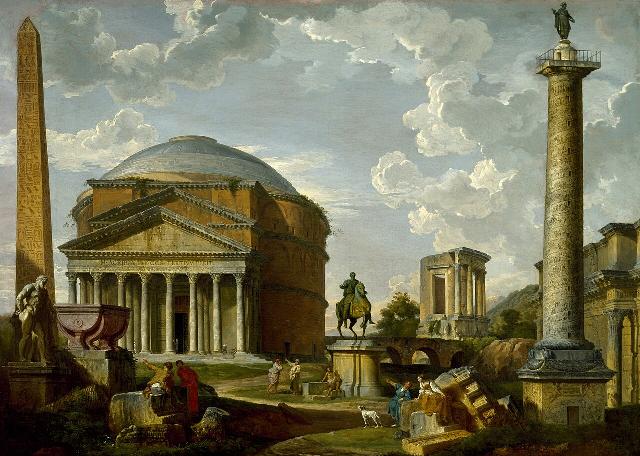



From Wikipedia Commons: Fantasy View with the Pantheon and other Monuments of Ancient Rome (Giovanni Paolo Panini, 1737)
It goes back to the temples, amphitheaters, and arenas of ancient Greece, of course. We owe everything to the old masters. Aesthetic ideals representing Western civilization until the mid-twentieth century originate from the superior perception of beauty cultivated in antiquity.
Centuries before the free citizens of Attica entered history, there were the construction principles of Mesopotamians and Egyptians whose superhuman monuments — “megastructures” resembling anthills because of their man-to-building proportions — stand to this day (i.e. ziggurats and pyramids, respectively). As an inspiration for the dystopian science fiction metropolis, from George Orwell’s “1984” to Frank Herbert’s “Dune”, they are infinitely far from the classical idiom. Part of the special contribution to aesthetics made by leading architect Ictinus and his followers, including Vitruvius, is that it treated man as an end in himself rather than a means — an insignificant ant.
The trends of democratic Athens, standing out for their relative lightness and elegance, broke with the penchant for altar-like, massive structures characteristic of Mesopotamia and Egypt. In harmony with a fundamentally different view of humanity, classical architecture refused to stage a ceremonial worship associated with human sacrifice. — Accidentally, a tyrannical view of people and worship has led to the construction of gigantic pyramids across the globe, including Mesoamerica. Also the oversized buildings planned by Stalin and Hitler, but never realized (i.e. Palace of Soviets, Moscow, and Volkshalle, Berlin, respectively), align with this megalomania. Ceaușescu, ordering the People’s House, Bucharest, had his way, though.
Western philosophers and other scholars have discussed the essence of beauty for centuries. As humans, we seek it not only in nature, whether in the environment that we inhabit or in our fellow human beings. Obviously, we also try to evoke it in the artifacts that we leave behind, be they buildings, gardens or works of art.
As befits its legacy, classical architecture is praised for its harmonious proportions, symmetry, and delicate ornamentation — usually inspired by natural forms like leaves, flowers, and human anatomy. The organic motifs of classicism constitute a varied and permanent source of enjoyment. Naturalistic, flowing patterns (acanthus leaves, floral friezes, human figures) reflect an everlasting connection to the organic world, life, and human experience. Beauty derives from a balance between order — something imposed on matter by man — and the complexity of nature, creating an uplifting, human-centered aesthetic.
Undoubtedly, the classical idiom is intended to evoke deep emotional resonance, reinforcing cultural paradigms of harmony while equally promoting the idea of a dual connection to the divine and nature. Unlike geometric abstractions, organic motifs suggest growth, fluidity, vitality, and imperfection — altogether features of living systems. They appeal to human senses beyond logic: emotion, intuition, and spirituality.
In classical architecture, organic motifs counterbalance rigid structural demands, generating spaces that feel alive and relatable. To some extent, this effect permeates all styles rooted in antiquity, including Renaissance, Baroque, and Art Nouveau. The psychological impact of classical aesthetics is well-known: organic designs feel warm, inviting, and comforting, fostering a sense of belonging and human-scale acceptance.
The diametrically opposite of everything beautiful and inviting, modernism has seriously challenged humanity, signifying a nihilistic revolution against the aesthetic traditions of antiquity. Modernist architecture is characterized by minimalism, clean lines, geometric forms, and flagellant renunciation of ornaments. Prominent members of the modernist movement, which built momentum after WWI, were Walter Gropius (founder of the Bauhaus), Le Corbusier, and Mies van der Rohe.
Not without reason, intellectual critics — as opposed to inarticulate users — have accused modernist architects of “dehumanizing” the environment. In their view, it has become aesthetically impoverished. The modernist idiom is typically described as detached, sterile, and alienating. Rejecting emotional or sensory gratification, it values abstraction, function, and efficiency.
Modernism has over time been associated with mental health conditions requiring psychiatric evaluation, if not treatment, including autism spectrum disorders (ASD) and PTSD (shell shock). Occasionally, when the debate degenerates into polemical attacks, the neuropsychiatric notion “autistic” is used to capture an extreme tendency to systematize or an apparent obsession with order and logic. This rhetorical trick draws on parodic stereotypes and prejudices about ASD (i.e. rigid patterns, perfectionist standards, and literal thinking). Although insinuating, the analogy is resorted to by critics to highlight how the geometric simplicity of modernism may feel emotionally and socially alienating.
In pursuit of “purity” in one sense or another, desiring to cleanse architecture from the influence of tradition, modernists imagined somewhat arrogantly that they were called to “ban” (a) structural conventions (e.g. arches, pediments, columns), (b) equally conventional decorations (i.e. plants, animals, humans), and (c) “irrational” fascination with a distant past in order to stimulate progress, technology, and rationality.
The parties to the ideological conflict are clearly defined. Classical architecture, striking a balance between repetitive structural elements and organic motifs, is like a tribute to the complexity, warmth, and emotional richness of life since the beginning of time. It works through nature-inspired beauty, creating a human-centered aesthetic. In contrast, the geometric simplicity of modernist architecture reflects a radical showdown with tradition, allegedly focusing on functionality. It denies recognizable elements of the classical idiom and instead cultivates abstraction and mechanistic distancing from man as a living being with an innate desire for beauty.
The modernist design studio becomes a sterile laboratory populated by cold-hearted scientists playing with forms and functions. In their hands, people are but mindless insects which they place at will between inhospitable structures. The conceited architect, imagining that he has really thought of “everything”, watches untouched as they sicken and perish in the sarcophagi of humanity drawn by him. Accordingly, critics are outraged and accuse the modernist, who acts indifferent to aesthetic considerations and human emotions, of being “autistic”. His constructions look like evil experiments with humanity.
Reading “mental illness” into architectonic and artistic works could very well be an expression of malicious intent, deliberately discrediting the judgment of the authors. However, interpreting the counterintuitive opt-out of structural and ornamental beauty in modernism is an imperative necessity. We need to know “who” is actually reshaping the world right before our eyes. Identifying a connection between neurodivergent perception and a preference for the modernist idiom may also offer deeper insights into the human mind. The goal is not to limit individual freedom of expression, of course, but to understand which motives ultimately drive the choice of design. Modernism, considering its harmful effects, cannot be ignored.
That the so-called “hardwiring” of ASD might explain the “dehumanized” architecture of Le Corbusier in neurophysiological terms is an old suspicion. Favoring function over human-scale warmth and beauty, his buildings are thought to be cold, impersonal, and intimidating. The rigid geometry and repetitive modular units come across as rather mechanistic, limiting emotional and sensory engagement. His mass housing projects consistently neglect elementary emotional and social requirements shared by their human inhabitants.
Purified of beauty in any form, a mockery of the human spirit, and an oversized “inhabitation machine”, to stay in his own eccentric slang, “L’Unité d’Habitation”, a collectivist-totalitarian project conceived by Le Corbusier, boasting “communal amenities”, is rightly criticized for its Brutalist, bunker-like appearance. For melancholics prone to pensive moods, the total impact of the high-rise typology is like an invitation to jump off the roof.
Critics condemn Le Corbusier’s style as “autistic”. Insensitive to common tastes, he invariably puts rules, patterns, and systems above emotional, social or sensory gratification. His sparse interiors, hard materials (concrete, steel), and nonfigurative “ornamentation” generate austere spaces. Moreover, the sheer scale of certain projects are overwhelming. Le Corbusier’s work reflects extremes of 20th-century modernism — allegedly desiring to embrace “progress” and “rationality”, though evidently at the cost of social and cultural cohesion.
Man was made in the image of God. For sure, the architecture that best suits man, respecting his dignity and meeting his need for beauty, is classical. Its idiom bears the imprint of God. It is like an architectural language created in heaven.
Modernism marks a sinister return to the megastructures of the past, reducing man to an ant without individual significance. Modernism dehumanizes the environment. Fateful to realize, it is totalitarian in its essence. Its structures provide the backdrop to nightmares revolving around a future devoid of humanity. Indeed, without a loving god.
